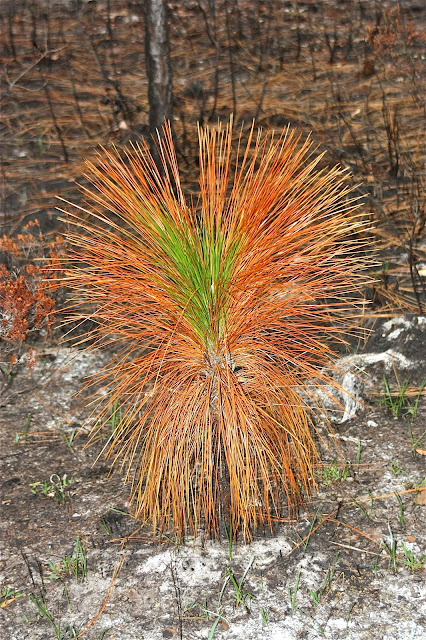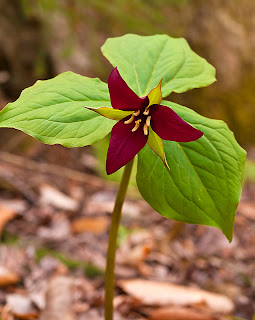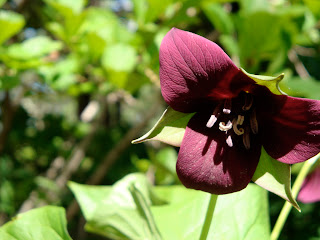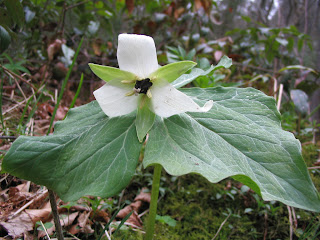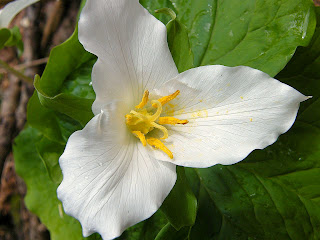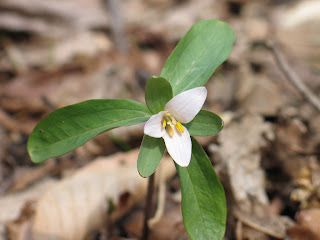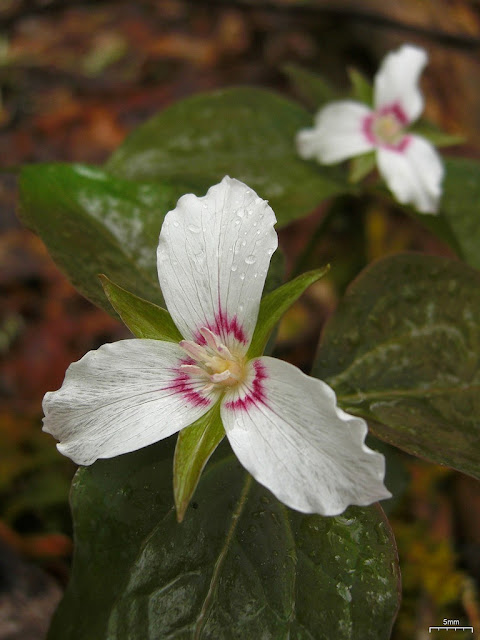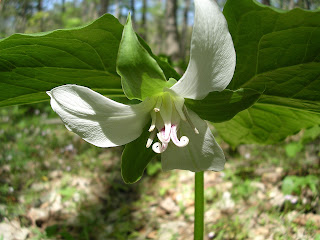We arrived in the parking area for The Nature Conservancy's Green Swamp Preserve about a half hour before dawn. When we got out of the car we were serenaded by the predawn songs of Bachman's Sparrows and Southern Cricket Frogs. The Green Swamp Nature Conservancy Preserve is made up of Long-leaf Pine savannas that are separated by pocosins which are swampy areas with heavy undergrowth of tall shrubs and Pond Pine.
Photo: Green Swamp Long-leaf Pine savanna, Jim Brighton
Once it got light we headed into the savanna by following a well marked trail. I had very simple directions to where the flytraps were supposed to be and fortunately for us they were spot on. After about 10 minutes of searching, I stumbled upon a small patch of Venus Flytraps.
Photo: Venus Flytrap, Jim Brighton
Venus Flytrap is native to an extremely small area in North Carolina and South Carolina. If you drew a 60 mile radius around Wilmington, NC this would be the range in its entirety. Flytraps only grow in soils that are low in nitrogen and phosphorous. This type of soil is often found in bogs and wet pine savannas. In my opinion, Venus Flytraps are one of the strangest and coolest plants.
Photo: Venus Flytraps, Jim Brighton
Photo: Venus Flytrap, Jim Brighton
With our main target checked off the list, we went and explored some of the farther reaches of the preserve. Because they burn the pine woods regularly, the understory of the savanna consisted mainly of wire grass (Aristida stricta) and small shrubs.
Photo: Burned Long-leaf Pines, Jim Brighton
Fire is very important because it kills the undergrowth. In a pine savanna habitat most of the plant species require direct sunlight. The heavier the understory, the less sunlight plants like Venus Flytraps and pitcher plants receive, eventually causing them to die. Long-leaf Pines are fire resistant and fire is an important part of the pines ecology. A young Long-leaf Pine doesn't resemble a tree, but looks more like grass.
Photo: young Long-leaf Pine, Jim Brighton
Even in this stage the young pine is very fire resistant. The needles will burn, but the stem will remain alive. On the University of Florida's School of Forest Research and Conservation website, they describe the young stage of Long-leaf Pines, "Unlike most conifers, the first 3 to 7 years of longleaf pine growth do not involve stem elongation. Rather, it remains a fire resistant, stemless, dense cluster of needles resembling tufts of grass. During this stage, seedlings are developing a deep taproot system below the ground and are capable of sprouting from the root collar if the top is damaged."
Photo: young burned Long-leaf Pine, Jim Brighton
With a dense understory the young pines would not have enough sunlight to grow, especially since it takes the tree almost 10 years to gain any real height. Controlled burns conducted by the Nature Conservancy and the state are held on the preserve every couple years.
We saw many cool plants. Below are the three species of Pitcher Plants that we observed.
Photo: Sarracenia rubra (Sweet Pitcher Plant), Jim Brighton
Photo: Sarracenia purpurea (Purple Pitcher Plant), Jim Brighton
Photo: Sarracenia purpurea (Purple Pitcher Plant), Jim Brighton
Photo: Sarracenia flava (Yellow Pitcher Plant), Jim Brighton
Photo: Sarracenia flava (Yellow Pitcher Plant), Jim Brighton
We saw another type of carnivorous plant called Yellow Butterwort (Pinguicula lutea).
Photo: Pinguicula lutea (Yellow Butterwort), Jim Brighton
Photo: Pinguicula lutea (Yellow Butterwort), Jim Brighton
Photo: Pinguicula lutea (Yellow Butterwort), Jim Brighton
Butterworts trap small insects with globs of sticky material that sit on the tip of fine hairs that grow on the plants leaves.
One of the other pine savanna specialties that we saw was the Pineland Daisy (Chaptalia tomentosa). It is one of the few asters that bloom in the spring.
Photo: Chaptalia tomestosa (Pineland Daisy), Jim Brighton
We saw two species of violets Viola lanceolata (Bog White Violet), Viola septemloba (Southern Coastal Violet), and one hybrid violet, Viola x primulifolia)
Photo: Viola septemloba (Southern Coastal Violet), Jim Brighton
Photo: Viola x primulifolia (Primrose-leaved Violet), Jim Brighton
We found a small patch of Common Pixie-moss (Pyxidanthera barbulata).
Photo: Pyxidanthera barbulata (Common Pixie-moss), Jim Brighton
Yellow Jessamine (Gelsemium sempervirens), a flowering vine, was growing everywhere. It was by far the most abundant flowering plant that we saw during our trip.
Photo: Gelsemium sempervirens (Yellow Jessamine), Jim Brighton
Photo: Gelsemium sempervirens (Yellow Jessamine), Jim Brighton
Photo: Gelsemium sempervirens (Yellow Jessamine), Jim Brighton
The preserve wasn't only Long-leaf Pine savanna. In between the savannas there existed dense thickets of small trees and shrubs called pocosins. Luckily there was a trail through the pocosins or we might not have ever found the pine savannas.
Photo: Trail through a pocosin, Jim Brighton
Pond Pine (Pinus serotina) is a pine that is often found growing in or near pocosins. You can easily tell Pond Pine by the many needles growing out of the trunk. The needles are the size of Loblolly Pine needles (7" long) which made it easy to differentiate from the Long-leaf Pine whose needles are typically 13" long.
Photo: Pinus serotina (Pond Pine), Jim Brighton
One of the dominant shrubs in the pocosins was Inkberry (Ilex glabra). Inkberry belongs to the Holly family and like its name the berries are black.
Photo: Ilex glabra (Inkberry), Jim Brighton
In one of the pocosins we found a Myrtle Holly (Ilex myrtifolia). This is a holly that grows on the coastal plain of the southeastern United States. Its leaves are only about an inch long.
Photo: Ilex myrtifolia (Myrtle Holly), Jim Brighton
Netted Chain Ferns (Woodwardia aureolata) and Virginia Chain Fern (Woodwardia virginica) were both found growing in the pocosins.
Photo: Woodwardia virginica (Virginia Chain Fern), Jim Brighton
Bracken Fern (Pterdium aquilinum) was growing in the dry sandy areas in the pine savanna.
Photo: Pterdium aquilinum (Bracken Fern), Jim Brighton
We had been skirting thunderstorms all day. Luckily, they had been moving north of us, but in the early afternoon they hit our area hard. We decided to drive the back roads of Brunswick County and see what we could find. One of the common roadside plants was Yellow Thistle (Cirsium horridium).
Photo: Cirsium horridium (Yellow Thistle), Jim Brighton
Cirsium horridium (Yellow Thistle), Jim Brighton
Photo: Cirsium horridium (Yellow Thistle), Jim Brighton
During a brief break in the rain we spotted a flowering tree growing in a boggy area along the road. We eventually figured out that it was Common Sweetleaf (Simplocos tinctoria). This is the host-plant for King's Hairstreak. Unfortunately, we didn't find any nectaring hairstreaks.
Photo: Simplocos tinctoria (Common Sweetleaf), Jim Brighton
With the rain still coming down we decided to head towards the coast to the Nature Conservancy's Preserve at Boiling Spring Lake. After a one hour drive we pulled into the preserve's parking lot. Immediately, we viewed white flowers that seemed to be growing everywhere along the parking lot and trail. The white flowers turned out to be Sand Myrtle (Leiophyllum buxifollium), a rare plant that grows in sandy barrens in the Carolinas and New Jersey.
Photo: Leiophyllum buxifolium (Sand Myrtle), Jim Brighton
It was getting very late and we were losing light. Most of the habitat along the path at Boiling Lake Springs Preserve had been recently burned, but with the last rays of light we identified a few more uncommon plants. Two southern oaks were common in the preserve, American Turkey Oak (Quercus laevis) and Live Oak (Quercus virginiana), but the highlight was finding a small patch of Dwarf Woodland Iris (Iris verna). These flowers were only a couple inches high and they were growing in a dry sandy upland habitat.
Photo: Iris verna (Dwarf Woodland Iris), Jared Satchell
With the day over we got back to the car and headed for home. We left Boiling Springs Lake at 8pm and Jared and I got back to Easton, MD at 4:35am Sunday morning. What a day! The next post is going to be on the animals that we saw on our trip. There were lots of cool finds, like Eastern Glass Lizard!


